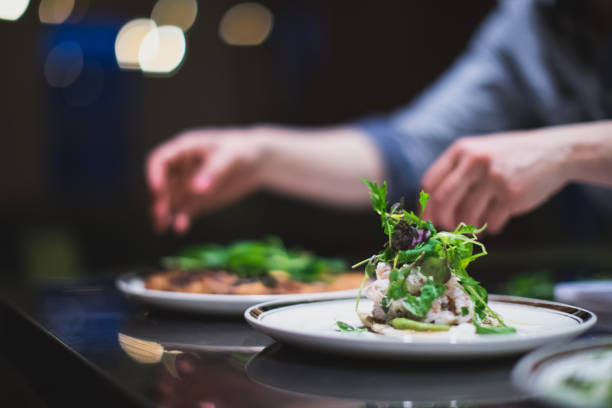Culinary Alchemy: Transforming Humble Ingredients into Gourmet Delights
Unlock the secrets of culinary alchemy and elevate everyday ingredients to gourmet status. This art of transformation isn't just for Michelin-starred chefs – with a dash of creativity and the right techniques, you can turn simple staples into extraordinary dishes that will wow your taste buds and impress your dinner guests.

The Art of Flavor Layering
One of the fundamental techniques in culinary alchemy is the art of flavor layering. This involves building complex taste profiles by combining different flavors and textures in a single dish. The goal is to create a harmonious balance that tantalizes the palate and keeps diners intrigued with every bite. Start by identifying the base flavor of your main ingredient, then consider complementary tastes that can enhance it. For example, when working with a mild-flavored fish, you might layer in citrus notes, herbaceous elements, and a touch of heat to create a more dynamic dish. Texture also plays a crucial role in flavor layering. Combining crispy, crunchy, and creamy elements can elevate a simple dish into a multisensory experience. Think of a creamy risotto topped with crispy fried sage leaves, or a velvety soup garnished with crunchy croutons. By mastering the art of flavor layering, you can transform even the most basic ingredients into a symphony of tastes and textures that will delight and surprise your diners.
Transformative Cooking Techniques
Innovative cooking techniques can dramatically alter the flavor, texture, and appearance of ingredients, turning the ordinary into the extraordinary. One such technique is sous-vide cooking, where ingredients are sealed in airtight plastic bags and cooked in a temperature-controlled water bath. This method allows for precise cooking and can transform tough cuts of meat into tender, flavorful delicacies. Another transformative technique is smoking, which can add depth and complexity to a variety of ingredients, from meats and fish to vegetables and even cocktails. Fermentation is another powerful tool in the culinary alchemist’s arsenal, capable of transforming simple ingredients into complex, probiotic-rich foods with unique flavors. Even simple techniques like caramelization can work wonders – turning basic onions into a sweet, rich condiment that can elevate burgers, steaks, or even be used as a base for French onion soup. By experimenting with these and other innovative cooking methods, home cooks can unlock new dimensions of flavor and texture in their everyday ingredients.
The Power of Unexpected Pairings
One of the most exciting aspects of culinary alchemy is the discovery of unexpected flavor pairings that can transform familiar ingredients into entirely new experiences. This approach challenges traditional culinary rules and encourages experimentation, often leading to delightful surprises. For instance, the addition of a pinch of salt to chocolate can enhance its sweetness and complexity, while a drizzle of honey on pizza can create a perfect balance of sweet and savory. Herbs and spices can also play a crucial role in creating unexpected flavor combinations. Try adding a hint of lavender to lemon desserts, or infusing vanilla into savory dishes like roasted chicken or mashed potatoes. Even fruits can find their way into savory dishes, such as figs in a prosciutto salad or pineapple in a spicy salsa. The key is to start with small amounts and adjust to taste, allowing your palate to guide you in creating harmonious and innovative flavor profiles.
Presentation: The Final Touch of Transformation
In culinary alchemy, the visual presentation of a dish is just as important as its taste. The way food is plated can significantly impact the dining experience, turning even the simplest ingredients into a work of art. Start by considering the color palette of your dish – contrasting colors can make ingredients pop and create a more appealing plate. Use negative space effectively; sometimes, less is more when it comes to plating. Experiment with different textures and heights to add dimension to your dish. For example, a smooth puree can serve as a base for crispy elements, while vertical components like microgreens or crisp vegetable strips can add height and visual interest. Don’t forget about the power of garnishes – a sprinkle of vibrant herbs, a drizzle of flavored oil, or a dusting of spices can elevate the visual appeal and add final flavor notes. Remember, we eat with our eyes first, so taking the time to thoughtfully present your culinary creations can transform a good meal into an unforgettable dining experience.
Culinary Alchemy Tips & Facts
• Always start with high-quality, fresh ingredients for the best results
• Experiment with different cooking temperatures to achieve various textures
• Use herbs and spices to add depth and complexity to simple dishes
• Don’t underestimate the power of acid (like lemon juice or vinegar) to brighten flavors
• Invest in a good set of knives and learn proper cutting techniques for better texture and presentation
• Understanding flavor profiles can help in creating successful unexpected pairings
• Layering flavors throughout the cooking process, rather than just at the end, creates more complex dishes
• Properly seasoning at each stage of cooking is crucial for developing full flavor potential
• Learning to balance sweet, salty, sour, bitter, and umami flavors is key to culinary alchemy
• Presentation techniques like quenelling and micro-plating can elevate simple ingredients
In conclusion, culinary alchemy is an exciting journey of transformation that can turn everyday ingredients into extraordinary culinary experiences. By mastering techniques like flavor layering, innovative cooking methods, and unexpected pairings, home cooks can create dishes that rival those found in high-end restaurants. Remember, the key to successful culinary alchemy lies in experimentation, creativity, and a willingness to challenge traditional culinary boundaries. So, embrace your inner alchemist, and let your kitchen become a laboratory of delicious innovation. With practice and passion, you’ll soon be turning the ordinary into the extraordinary, one dish at a time.





